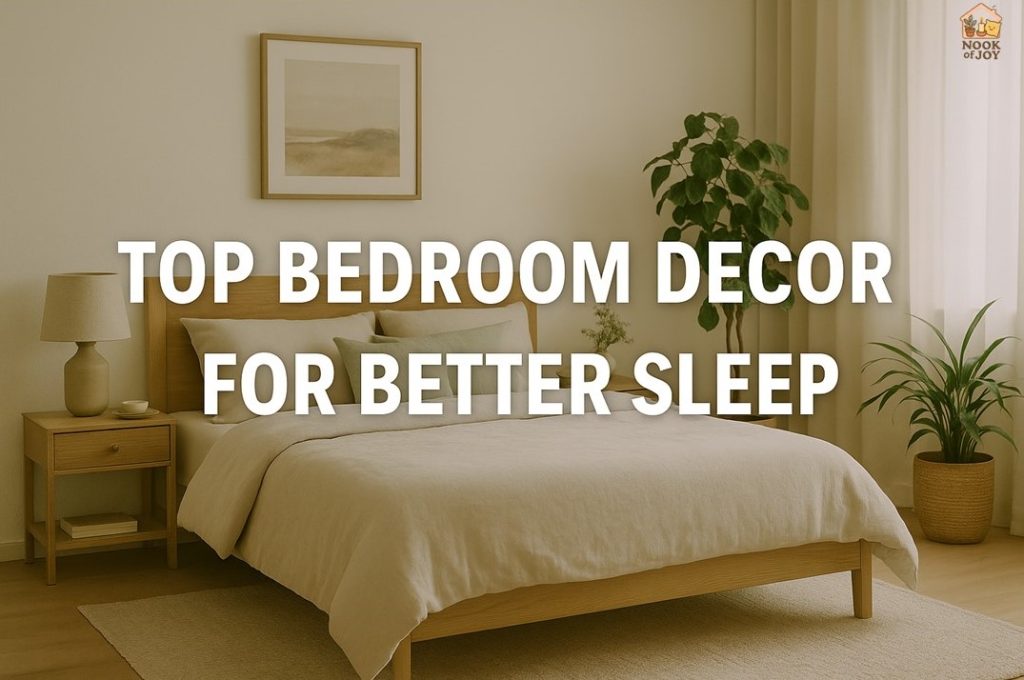
Why Bedroom Decor Matters for Sleep?
Our surroundings shape our mood, and nowhere is this truer than in the bedroom. Whether you are struggling with sleepless nights or simply want deeper, more restful slumber, your bedroom decor for better sleep could be the secret ingredient. Soft lighting, soothing colors, clutter-free spaces, and cozy textures can cue your body to relax and recharge.
Top Bedroom Decor for Better Sleep
Let us break down the design elements that can make your bedroom not just beautiful, but also deeply restful.
1. Choose Soothing Colors That Calm the Mind
Color is one of the most powerful tools in shaping the ambiance of a space. In a bedroom, it sets the emotional tone for winding down.
Best Sleep-Inducing Colors:
- Pale blue: Evokes serenity and is proven to reduce heart rate and blood pressure.
- Soft greens: Reminds the brain of nature and promotes calm.
- Cool greys, creams, and taupes: Provide a clean canvas that does not overstimulate.
- Lavender or blush pink: Can feel romantic and soothing in the right shade.
What to Avoid:
- Bold reds or fiery oranges: These colors increase alertness and can elevate stress.
- Neon tones or highly saturated hues: Stimulating and distracting.
- High-gloss finishes: Reflect light and can create harsh contrasts.
Tip: Stick to matte or eggshell paint, and opt for two-tone or monochrome palettes for a balanced, tranquil look.
2. Layer Lighting for Ambiance and Sleep Readiness
Lighting should evolve with your day—bright in the morning, soft and warm by evening. A well-thought-out lighting scheme is essential to effective bedroom decor for better sleep.
Ideal Lighting Plan:
- Overhead lighting on dimmers: Allows you to reduce brightness as bedtime nears.
- Bedside lamps with warm white bulbs (around 2700K): Help signal to your body that it is time to relax.
- Accent lighting: LED strips behind a headboard or under floating shelves can add a soft glow.
- Natural light: During the day, it helps regulate your circadian rhythm—use sheer curtains to let in light while maintaining privacy.
What to Avoid:
- Cool white or blue-hued bulbs (>5000K): These suppress melatonin and trick your brain into staying alert.
- Harsh spotlights or uncovered LED bulbs: Create glare and overstimulation.
- Excessive backlit tech: TVs, phones, and tablets emit disruptive blue light.
Tip: Use a smart bulb system with a sunset simulation feature to support your bedroom decor for better sleep goals.
3. Prioritize Comfort with High-Quality Bedding
Your bed is more than just furniture—it is the foundation of good sleep. Quality bedding is a core component of bedroom decor for better sleep, as it offers tactile comfort and helps regulate body temperature.
Bedding Must-Haves:
- Sheets: Opt for breathable natural fabrics like cotton, bamboo, or linen. A thread count between 300 and 500 is ideal.
- Mattress: Memory foam, hybrid, or spring—choose based on your sleep style. Firmness should align with your body weight and preferences.
- Pillows: Side sleepers may need firmer support, while back or stomach sleepers do better with medium to soft pillows.
- Blankets & Comforters: Choose all-season comforters or layer with lightweight quilts. Weighted blankets are great for reducing stress.
What to Avoid:
- Synthetic bedding materials: Polyester traps heat and can lead to night sweats.
- Worn-out pillows: Lose their support and collect allergens.
- Loud prints or busy patterns: Can be visually jarring.
Tip: Choose calming colors like oatmeal, powder blue, or soft sage for your bedding to blend into the sleep-ready atmosphere.
4. Declutter for a Clearer Mind and Better Sleep
Clutter in the bedroom creates mental noise, making it harder to fall or stay asleep. A tidy space is the hallmark of effective bedroom decor for better sleep.
Ways to Declutter:
- Nightstand with drawers: Hide away phone chargers, remotes, and books.
- Under-bed storage boxes: Keep seasonal clothes or extra linens tucked away.
- Minimal furniture: Keep only essentials—bed, two side tables, a dresser, and maybe one accent chair.
- Wall-mounted shelves: Offer storage without taking up floor space.
What to Avoid:
- Open shelving with lots of items: Makes the space feel busy.
- Unmade bed: Encourages messiness and hinders the sense of retreat.
- Laundry piles or unused furniture: Create a feeling of overwhelm and disorganization.
Tip: “If it does not serve you daily or bring you joy, it does not belong in your sleep space.”
5. Incorporate Natural Elements for Balance and Serenity
Bringing nature inside helps anchor us and reduce stress levels. A few well-placed natural accents can work wonders.
Calming Touches:
- Indoor plants: Snake plant, pothos, aloe vera, and lavender all purify air and are low-maintenance.
- Wooden accents: Reclaimed wood headboards, bamboo blinds, or teak nightstands add organic warmth.
- Natural textiles: Cotton drapes, linen throws, or jute rugs promote a cozy and grounded feeling.
What to Avoid:
- Too many plants: They can overcrowd the room or become a maintenance burden.
- Fake greenery or plastic accents: These do not carry the same mood-enhancing effects as real elements.
- Cold, synthetic furniture finishes: High-gloss plastic or laminate lacks the warmth of real wood.
Tip: Place plants near windows for natural growth and add stone or clay decor pieces to complement the theme.
6. Curate Sound and Scent for Multi-Sensory Calm
Your senses play a critical role in preparing for sleep. Soft sounds and calming scents can act as rituals to ease you into dreamland.
Sensory Additions:
- Sound: Use a white noise machine, sleep playlist, or a small tabletop fountain for a soothing background.
- Scent: Use essential oils like lavender, sandalwood, or vetiver in a diffuser or spray your linens before bed.
- Soft textures: Faux fur throws, velvet cushions, or silk pillowcases can enhance tactile comfort.
What to Avoid:
- Loud alarm clocks or ticking wall clocks: These disrupt restful sleep.
- Overpowering scents or synthetic air fresheners: Can cause headaches or allergies.
- Rough, itchy fabrics: Low-quality textiles can lead to skin irritation and discomfort.
Tip: Our ceramic diffusers double as elegant decor, perfect for creating a sensory sleep ritual.
7. Add Personal Touches Without Visual Noise
Personal expression should not come at the cost of tranquility. Balanced personalization is key in bedroom decor for better sleep.
Personalize with:
- A few framed photos or prints that bring positive emotions.
- Books or journals that help you wind down (avoid thrillers or work-related reads).
- A reading nook with a soft chair and blanket for evening reflection or meditation.
What to Avoid:
- Busy gallery walls: Too many images can create visual clutter.
- Brightly colored decor pieces: Distract rather than soothe.
- Too many knick-knacks: Dust collectors that may serve no real purpose.
Tip: Follow the “1-in, 1-out” rule—if you bring something new in, remove something to keep the balance.
8. Create a Digital-Free Wind-Down Zone
A modern sleep disruptor is tech overload. Creating a screen-free zone is a critical part of bedroom decor for better sleep.
Best Practices:
- Designate a charging station outside your bedroom.
- Replace phone alarms with analog clocks.
- Use books or meditation apps (audio only) as bedtime companions.
What to Avoid:
- TVs in the bedroom: Associated with poor sleep hygiene.
- Doom-scrolling or working from bed: Creates an association between your bed and stress.
- Laptops or tablets on the nightstand: Tempt you to stay mentally engaged.
Tip: Keep a gratitude journal and a cup of calming tea by your bed to encourage screen-free winding down.
Final Thoughts
Your bedroom should feel like a retreat from the world—a safe, serene space where you can rest, recharge, and feel at peace. From calming colors to cozy textiles, natural accents to tech boundaries, every design choice has the potential to enhance your sleep quality.
At Nook of Joy, we believe bedroom decor for better sleep is not just about design—it is about how your space makes you feel. Start with one change or embrace a full decor makeover—either way, your well-rested self will thank you.

